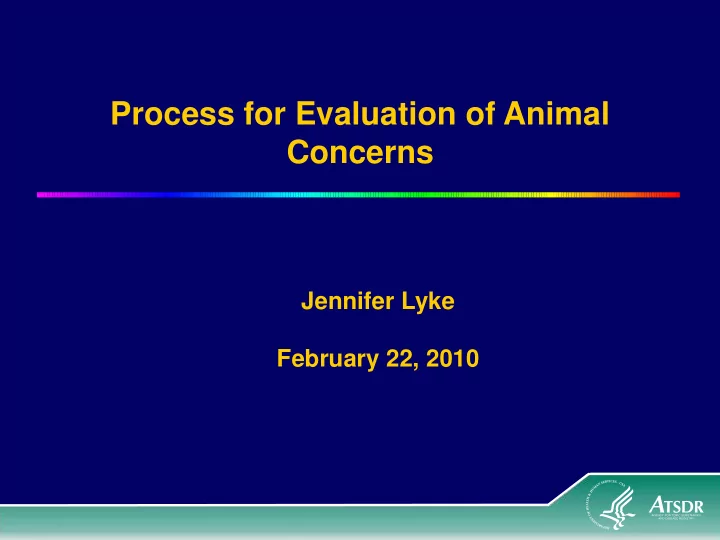

Process for Evaluation of Animal Concerns Jennifer Lyke February 22, 2010
Reported Animal Concerns 1. Reproductive problems • Infertility and small litter sizes (dogs, horses) • Cystic ovaries (horses) • Stillbirths and failure to thrive • Malformations • Genitals • Skeletal (limbs and feet) • Neural tube (spina bifida, hydrocephalus) • Body wall closure defects 2. Skin abnormalities •Acute and chronic (dogs) •Sweat glands (foals) 3. Cancers •Tumors in puppies and adult dogs
Reported Livestock Concerns Species reported: cattle, horses, sheep, goats, ostriches • Reproductive – infertility, cystic ovaries • Developmental • Skeletal deformities, body wall defects • Ocular: eye defects • Respiratory problems – acute and chronic • Immune function? • Needs further study and better clinical documentation
Limitations to Date • No incidence and prevalence data • No systematic collection of data • Limited access to veterinary and animal production records • Incomplete information on existing diagnoses and laboratory findings ** No routinely collected state or national animal health statistics exist for these conditions to use as comparison values.
Gathered Input 12/7/2009 – 12/11/2009 Met with the following veterinarians to gather input: • Texas Animal Health Commission • Texas State Veterinary Diagnostic Lab • Texas A&M College of Veterinary Medicine Specialists consulted: Toxicologist, Oncologist, Reproductive Health (Theriogenologist), Immunologist, Clinical Pathologist, Epidemiologist, Laboratory Services. • Local veterinarians at various clinics and animal hospitals serving the Midlothian area.
Next Steps • Determine if environmental data is sufficient and can be used to estimate doses for routes of exposure (companion animals and livestock). • Review veterinary and scientific literature for previous reports of toxicological information on contaminants of concern with respect to animal health issues. • Consider developing Provisional Animal Health Guidance Values (PAHGVs) for specific routes of exposure (air, soil, water, etc.) . • Utilize the PAHGV screening values to determine if adverse health outcomes are expected. • Incorporate findings as part of Public Health Consultation
Recommend
More recommend